Wabbu released the first picture of the exterior planet to find another earth to find another earth!
Author:Institute of Physics of the Ch Time:2022.09.14
In the early morning of September 2, 2022, the first outer planet image taken by the James Webb Space Telescope (hereinafter referred to as "Weibu") was announced, as shown in the figure below. This exogenous planet is numbered "HIP 65426 B", which revolves around a star revolution number "HIP 65426".
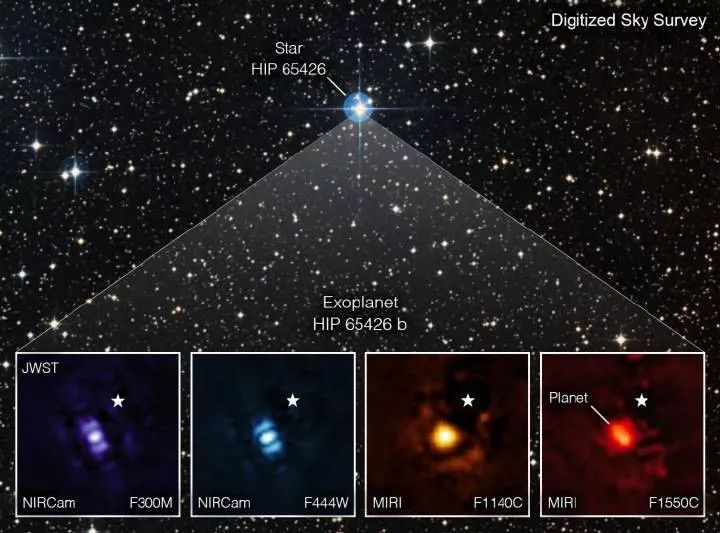
The star (big picture above) of the star HIP 65426 shot by the Digital Sky Tour (DSS) and the images of the starring planet (small below) taken by the star of the star (small picture below). The average wavelengths of this planet were 3.067 microns, 4.397 microns, 11.307 microns, and 15.514 microns, respectively. The white five -pointed star indicates the position of the star, and the light emitted by the star itself is blocked by the device. The stick -like image appearing in the picture is caused by the diffraction effect of the instrument, not a real image.
Image source: DSS; NASA/ESA/CSA, A. Carter (UCSC), The ERS 1386 Team, and A. Pagan (STSCI)
The big picture in the picture above shows the position of the stars surrounded by the shot planet. Four small maps are the images of the 4 bands of HIP 65426 B of the near -infrared camera (NIRCAM) and MiRI (Miri) of Weibu.
Some readers may say, "Well, aren't there any pictures of foreign planets in the first batch of Weibu's first batch of Weibu in July this year?" Yes. But the pictures of those two exogenous planets are not "images", but "light change curves" and "spectrum". Moreover, they are all the light variable curves and spectras shown by stars after being affected by the planet, not the planets themselves.
In addition, even if the planet itself is directly measured, the measuring light curve is only equivalent to measuring a person's wrist temperature over time, and the measurement spectrum is only equivalent to measuring the body temperature at a certain part of the body at a certain moment, but there is no but no Take a photo of this person.
This time, Webu took the "certificate photo" of an outer planet. This is the first time Wabbu has shot an image of the external planet. Although it is not the first image of the first batch of external planets obtained by humans, it is the first batch of images of the outer planet that human beings obtained more than 5 microns.
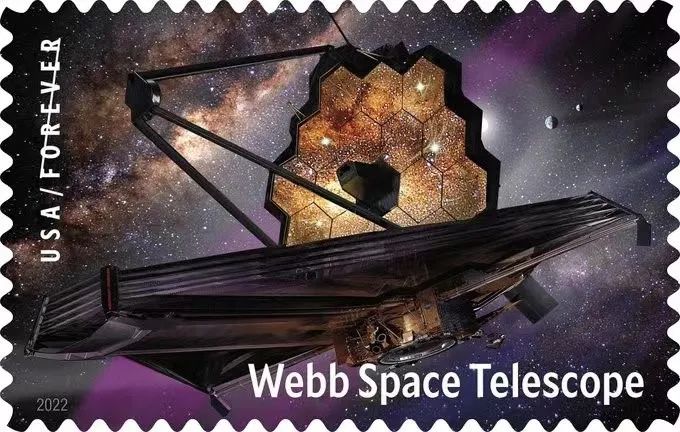
The commemorative stamp of the Weibu Space Telescope released on September 8, 2022
Image source: U.S. Postal Service
Outer planet "Zoo"
The eight major planets in our solar system are "internal planets in the solar system". We can refer to them as "internal planets", but we generally call them "planets". The planet outside the solar system is naturally "outer planet". We call their "mother stars" around the stars around the planet.
The outer planet is generally named in the following way: If the mother star has only one planet, add B directly behind the mother star; if there are 2 or more planets, continue to use C, D, E ...
This time the outer planet shot by Webb, the mother star is HIP 65426, so it is numbered "HIP 65426B"; the mother star of the exterior planet that Wabbou was detected before was WASP-96, so its number was " WASP-96B ".
From 1992 Humans confirmed the first outer planet. By September 6, 2022, humans confirmed a total of at least 5,471 outer planets. They were in at least 3811 systems similar to the solar system, of which there were not less than 2 planets There are at least 833 systems. [Note 1]
We know that although there are only eight major planets in the solar system, they can be divided into three categories: Mercury, Venus, Earth and Mars belong to rock planets, Jupiter and Saturn belong to giant giant stars, and Uranus and Neptune belong to the ice giant planet.
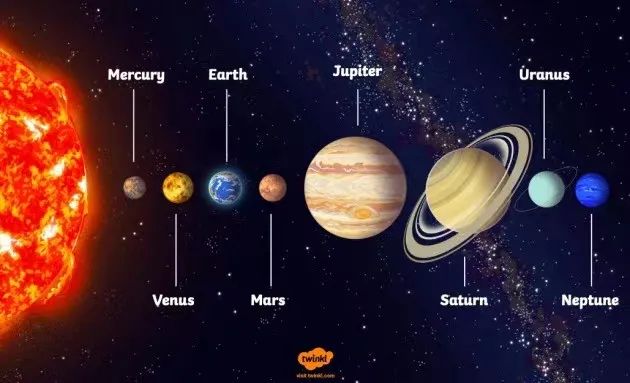
The "family portrait" of the eight major planets in the sun and solar system. The second from left to right is: Sun (part), Mercury, Venus, Earth, Mars (Mars), Jupiter, Saturn, Uranus and Neptune ), The distance between each celestial body and mutual mutual each other is not displayed in proportion.
Picture source: Twinkl
The type of exterior planet is more diverse than the planets in the solar system. Some exogenous planets are like the earth, but the quality is several times larger than the earth, so it belongs to "super earth"; some outer planets are like Jupiter, but because they are too close to the mother star, the temperature is much higher than Jupiter, so it belongs to " Hot Jupiter. Their quality distribution is also wide, and some of them are much larger than Jupiter, so they belong to "Super Jupiter", and some of them are only twice the quality of the moon.
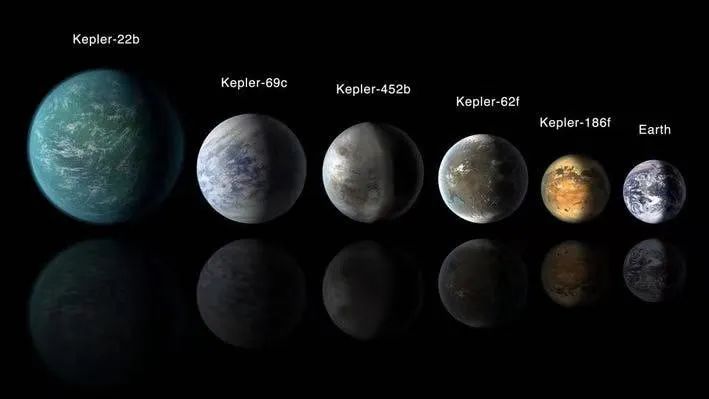
Some of the "super earth" art imagination collection and the size of them are compared with the size of the earth.
Image source: NASA/AMES/JPL-CALTECH
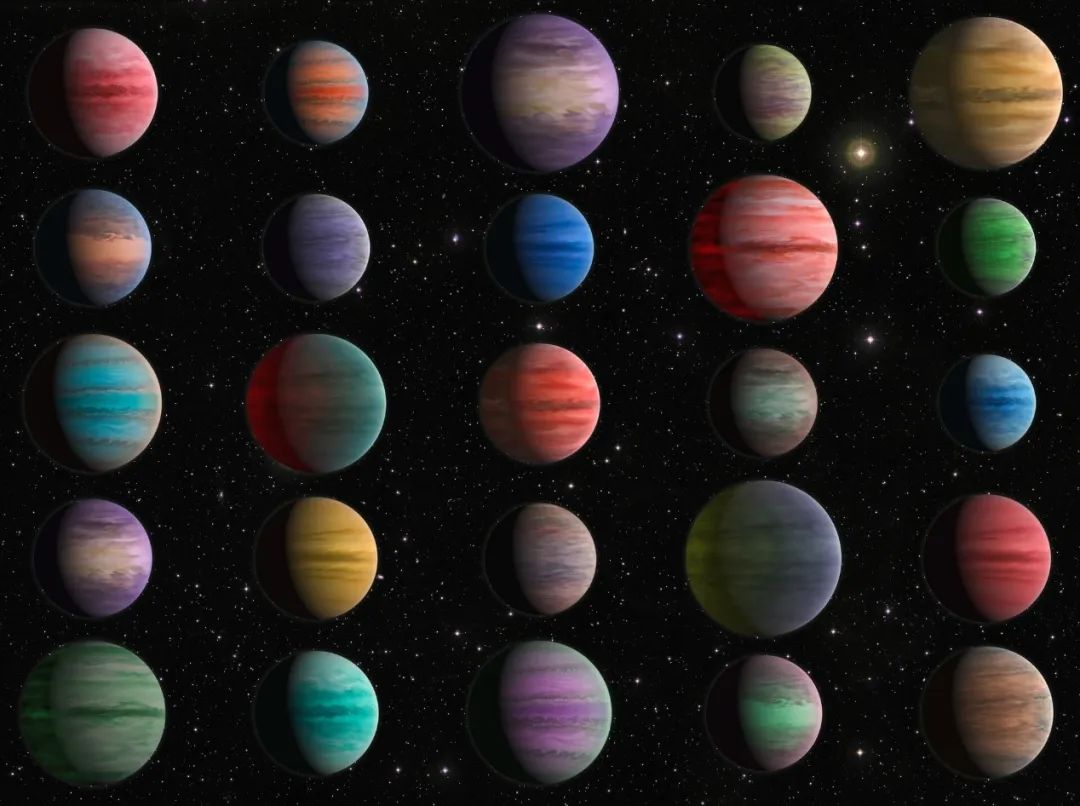
Hubble Space Telescope (HST) observed 25 hot Jupiter's artistic imagination collection.
Image source: ESA/Hubble, N. Bartmann
Although from the perspective of scientific research, each external planet has its unique value. However, in this rich exterior planet "zoo", human beings are most interested in those "livable planets" that are suitable and can generate liquid water on the surface, and are similar to the earth. How to discover an external planet?
It is difficult to find that the external planet is very difficult, because the brightness of the star itself is often far beyond the brightness of its planet. If you want to see the outer planet directly, the difficulty is equivalent to watching the fireflies next to the bonfire thousands of kilometers away.
However, with the development of science and technology, human beings first discovered the external planet in 1992. They are two planets around the neutron star, and the discoverers are Aleksander Wolszczan (1946-) and Dale Frail (1961-).
In 1995, humans first discovered the outer planets around the main stars, and the discoverer Michel Mayor (1942-) and Didier Queloz (1966-) won the 2019 Nobel Prize in Physics. The main sequence star refers to a star with only hydrogen fusion in the interior, and our sun is a main stars.
From 1991 to March 2022, the cumulative number of exogenous planets discovered by humans and the moving map of the position of the outer planet (in the small circle in the middle of the figure) discovered each year. The data in 2022 is still being updated, so the current total has exceeded the 5005 displayed in the figure.

Picture source: NASA/JPL
Until now, astronomers have developed a variety of indirect or direct methods of discovering exogenous planets. The most important are the following 4: Lingxing method, radial speed method, micro -lens lens lens method and direct imaging method. The outer planet found in these 4 methods accounts for about 97.88%of the total.
Click on
The method of discovering the exogenous planet
1. Ling Xingfa
The principle of Ling Xingfa is similar to Mercury or Venus. We know that Mercury or Venus Ling is because they have become a line with the sun and the earth during a certain period of time, thereby blocking a small part of the sun. If the external planet blocks a part of the light from the mother star, the "Ling Xing" phenomenon will be produced. For such a system, due to the periodic of the planet's cyclical transfer around the mother star, the brightness of the mother star will periodically reduce, recover, reducing, and recovery, and recover.
Wasp-96's light variable curve measured by Webb. According to the periodic decrease in its brightness, it can be inferred that a planet operates around it and blocks some of its light. This outer planet is WASP-96B.
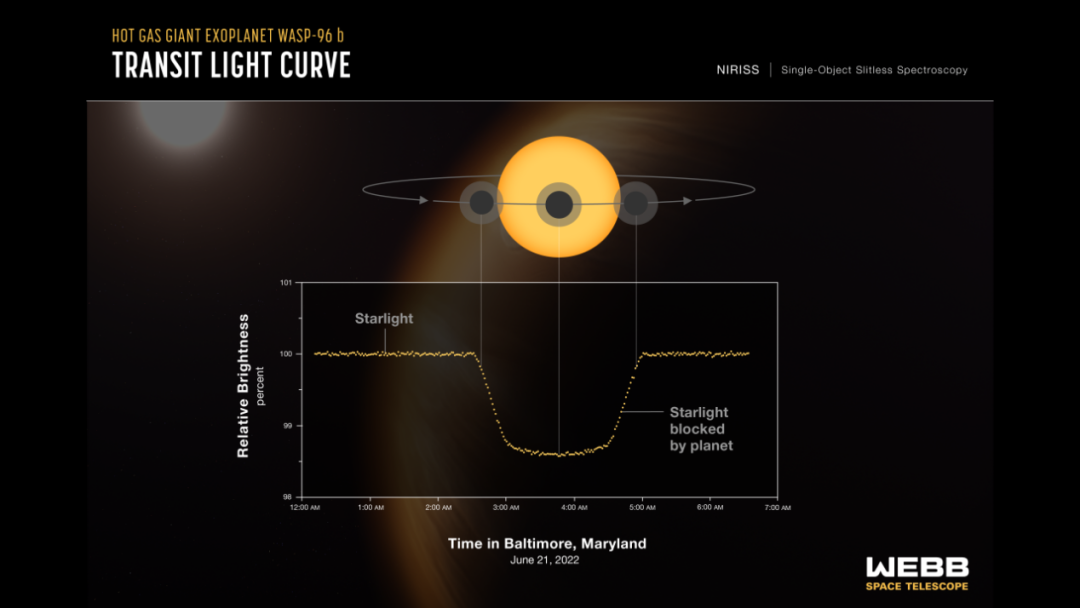
Image source: NASA, ESA, CSA, STSCI
The reduction of the star brightness caused by Ling Xing is very small, so it has very high requirements for the measurement accuracy of the instrument. Using this method, the representative of the outer planet is "Kepler Space Telescope (hereinafter referred to as" Capeler ") and its successor" TRANSITING Exoplanets Survey Satellite (TESS) ") Essence They all have a very wide field of vision, which can monitor the brightness changes of massive stars at the same time, thereby screening stars with cyclical changes in brightness in high efficiency. According to data, astronomers determine whether such changes are caused by Ling Xing of the outer planet.
The artistic imagination of the Cair Popler Space Telescope.
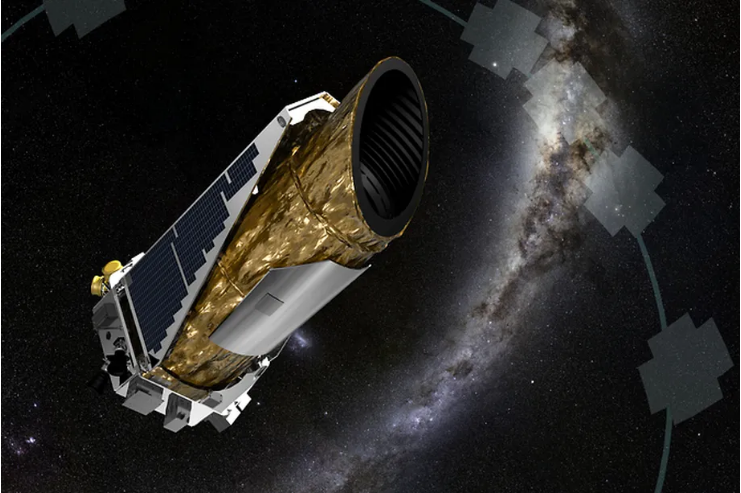
Picture source: NASA
The advantage of Ling Xingfa is that it can be repeatedly tested. So far, astronomers have discovered at least 3925 foreign planets with Ling Xingfa, accounting for about 71.74%of the total. Among the outer planets confirmed by Ling Xingfa, more than 2,700 were confirmed in the data detected by "Cairpler".
Ling Xingfa also derived the Ling Xing timing method. The principle is: the cycle of the planet Lingxing is fixed and accurate. If a star is inaccurate by Ling Xing's cycle, it may be that another planet interfere with its orbit, and the existence of the latter can be judged accordingly. Using this method, astronomers discovered 23 outer planets.
2. Ratial speed method
The radial speed method determines the speed of the star based on the changes of the star's spectrum, thereby judging whether the star has an external planet. Scientists use the instrument to separate the light from the objects (including the stars) into a fine rainbow belt. This is the spectrum.
The principle of the radial speed method is: when the stars are moving towards the earth, the wavelength of the light it emits will be shortened (blue shifts); when the star is far away from Earth, the wavelength of light will become longer (red shift) Essence
If the star has an exogenous planet, it will be dragged by the planet's gravitational gravity. It will turn around with the latter's common "quality heart" (as shown below), sometimes away from us, sometimes close to us, and its speed will appear cycle. Sexual changes (as shown in the top right of the figure below), which causes its spectrum to move sometimes, sometimes blue (as shown in the bottom right), and the circulation is reciprocating.
The light green × in the figure is the quality of the system composed of stars and planets. The upper right is the change of the star speed, and the red movement of the alternateness of the star spectrum on the bottom right is the red movement of the star spectrum.
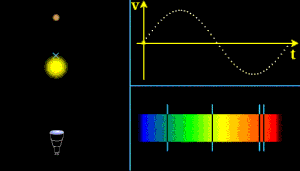
Image source: HomePage.divms.uiowa.edu
According to this principle, astronomers measure the degree of spectral red shift and blue shift, and calculate the speed of the star to calculate the quality of the planet. Because stars generally do not move directly in the direction of the earth, the speed can be decomposed into two directions: the speed towards the earth ("radial speed") and speed vertical in the direction of radial speed. Only the radial speed can be measured (this is also the origin of the name of the radial speed method), and the measurement value is always smaller than the real speed, so the quality of the outer planet calculated based on this method is only a lower limit.
One of the representative instruments of the external planet using radial speed method is the "high -precision radial speed planetar search" (High Accuration Radial Velocity Planet Searcher (Harps), which is installed on the Southern Observatory (ESO) of the European Southern Owners (ESO). The telescope of rice (the caliber of the telescope refers to its diameter of its lighting mirror).
ESO's caliber is a 3.6 -meter telescope (top) and a part of the internal structure of Harps (below).
Image source: s. Brunier/Eso (top); https://www.eso.org/public/teles-nstr/lasilla/36/harps/ (below)
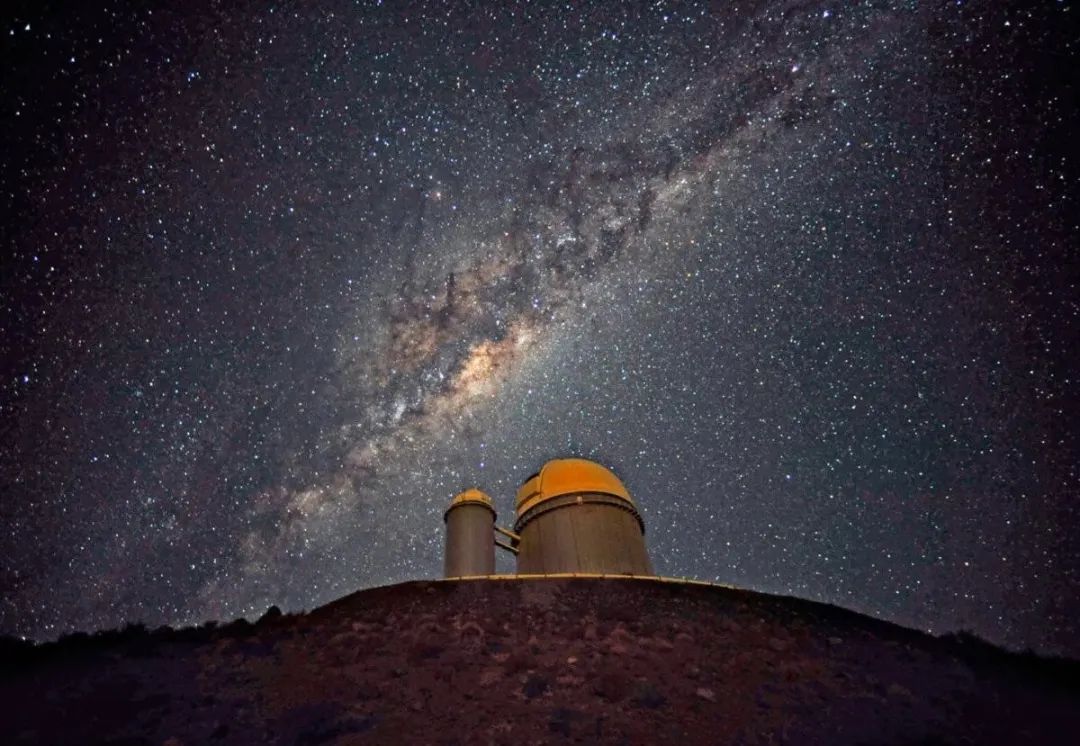

So far, astronomers have discovered 1005 foreign planets at the radial speed method, accounting for about 18.37%of the total. It is particularly worth mentioning that astronomers use this method to confirm in 2016 that the nearest star is the neighboring star, which has an outer planet, that is, "Proxima B" (Proxima B ". Earth.
The artistic imagination (right) of the planet "Proxima B", which is adjacent to the starring star, and compares it with the size of the earth. The quality of "neighboring star B" is slightly larger than the earth. The evidence of its existence was proposed in 2013 and was confirmed in 2016.
Image source: PHL @ Upr Arecibo, NASA EPIC Team
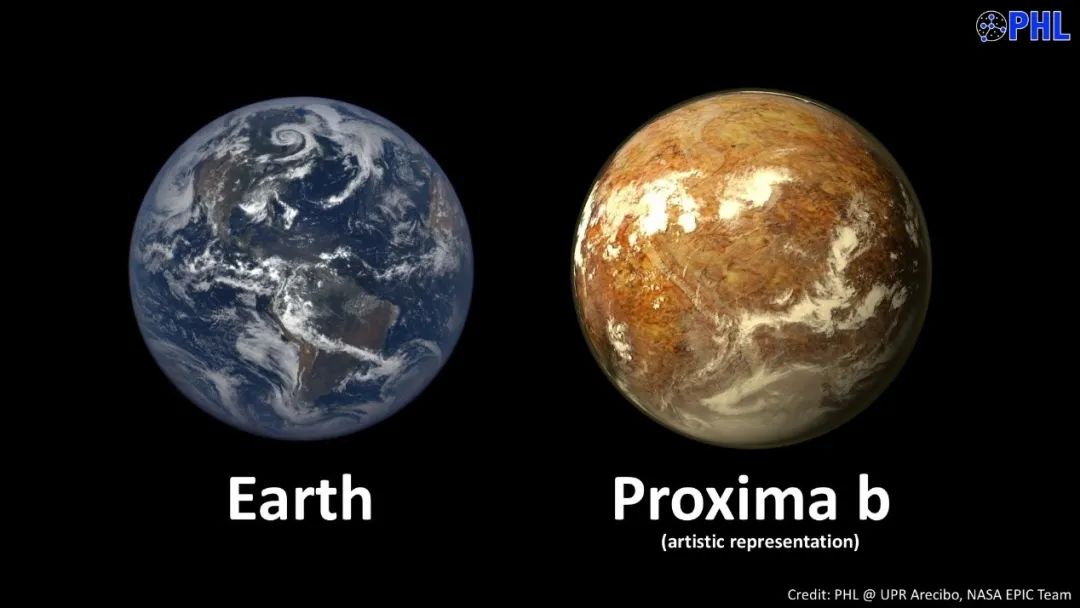
3. Micro -induced lens lens method
According to the general theory of relativity, quality objects will bend the surrounding space -time. When they pass through them, they will take the curve. If there is a large -quality celestial body between the light source and the earth, and the three are almost into the line, the latter will magnify the brightness (weak gravitational lens) like a lens, and even produce double or multiple images (strong gravity lens lens To. The celestial body that acts as a lens is a gravity lens.
In the process of drift of the celestial body of the weak gravitational lens, the magnification ratio of the brightness of the background celestial bodies will become larger and then smaller, and when it is closest to three or three points, the proportion of magnification will be the highest. Therefore, the weak gravity lens of the drift will change the brightness of the background light source, making the brightness brighten and darkened.
Micro -induced lens method diagram. The Source Star in the figure is a background star for light sources. Lens Star is a star who acts as a lens. Planet is a planet for micro -lens lens. Observer is an observer.
Picture source: NASA
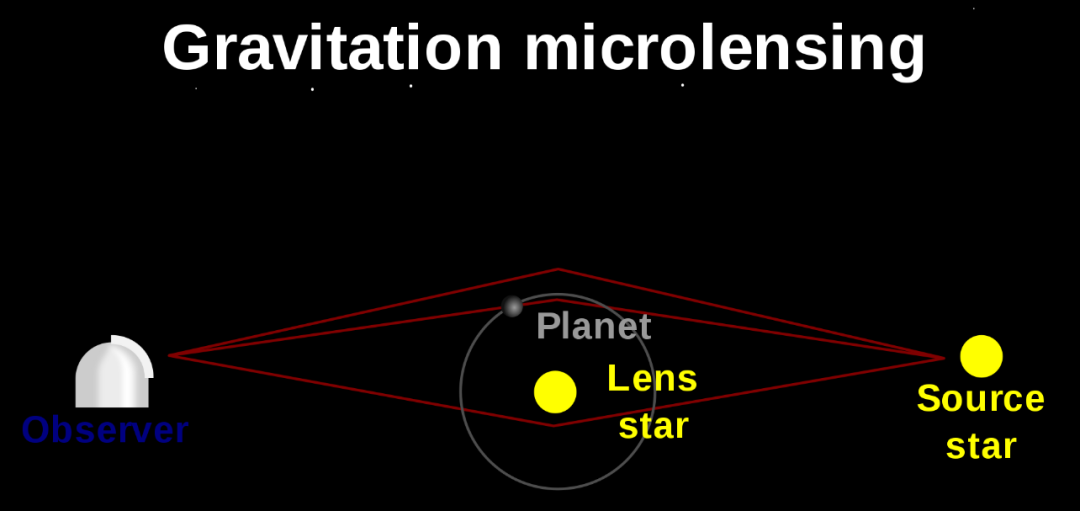
Drifting stars can become such a weak gravitational lens. If the star is still with a planet, during the process of the star drift, the planet also contributed additional contributions to the gravitational lens effect, resulting in the sudden change of light change curve that originally changed. effect. Such a peak is a signal that exists in the external planet.
So far, astronomers have discovered 212 outer planets with a micro -induced lens lens, accounting for 3.87%of the total. The disadvantage of the micro -induced lens method is that it cannot be repeated, because the star does not look back after drifting, but its advantages are clear signals.
The use of micro -lens lens method to find the representative instrument of the outer planet is the "Optical Gravity Mirror Experiment" (OGLE) and the "KMTNET" (KMTNet). The former is performed by a telescope with a diameter of 1 meter, and then executed by a telescope with a caliber of 1.3 meters; the latter is executed by 3 telescopes with a caliber of 1.6 meters.
Located on the dome with a caliber of 1.3 meters telescope in Chile's Las Campanas Observatory, it is used to perform the OGLE mission. Photo source: Krzysztof ULACZYK
4. Direct imaging method
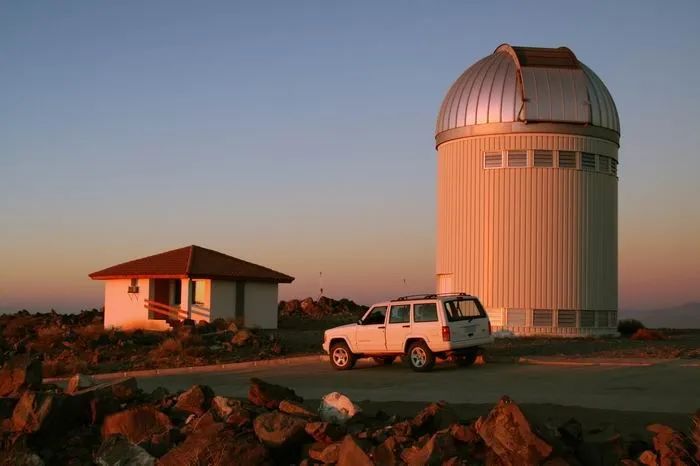
Lingxing method, radial speed method, and micro -lens lens lens method are the methods of indirect determination of external planets. They are not 100 % accurate, sometimes there are fake signals. In order to exclude fake signals, for some candidates for exotic planets, astronomers will try to cross inspection at the same time as much as possible.
However, even if people use the above three methods to completely confirm the existence of exogenous planets and infer some of their basic properties, they still cannot see these exogenous planets. Direct imaging can make up for the regret of "unable to see the outer planet".
If the ratio of the brightness of the mother star to the brightness of the planet is not very large, and the distance between the two is far enough, astronomers can directly shoot both, such as the low -brightness brown dwarf 2m1207 and the planet 2m1207B around it.
VLT-1 ("ANTU", which means "Sun") The brown dwarf 2M1207 and its planet 2m1207b nearly infrared pseudo-color images were shown as blue and white and red, respectively. 2M1207 is a low -brightness, a brown dwarf with a mass of only 25 times the quality of Jupiter, and the quality of 2M1207B is 3 ~ 10 times that of Jupiter. The light of the star does not occupy an overwhelming advantage, so it can be directly photographed at the same time. Picture source: ESO
However, due to the selection effect, humans are more likely to see bright stars, and their brightness is much higher than the planets around them. Therefore, astronomers must use a device called "Star Crown instrument" to block the light from the star, so as to take images of planets near the stars.

The technology of the star coriander is derived from the coronation instrument, which is used to block the light from the surface of the sun, which allows astronomers to observe the corona. The corona is the atmosphere of the outer layer of the sun, and it is named because its shape is like a hat ("crown"). Although the design goals of the aegant instrument are different from the starring instrument, they are essentially the light of the stars, allowing astronomers to shoot the substances or objects around the star.
Both the Nircam and Miri on the Webu are installed with a star corona, so they can block the strong light from the stars and directly shoot the planets next to them. But Weibu is not the first telescope with a star corona.
Earlier, some telescopes on the ground had been equipped with astrology instruments, and used direct imaging to shoot outer planets, such as Hale telescope with a caliber of 5.08 meters, KECK telescope with a caliber of 10 meters. 8.2 meters of a large telescope (VLT), a large binocular telescope (LBT) with a caliber of 8.4 meters, and so on. They are all representatives of telescope using direct imaging. After Webb took this group of photos, it also became one of the representatives of such telescopes.
Four VLT group photos. Two of them are installed with devices that can directly shoot the external planet.
Image source: IZTOK BONCINA/ESO
This time, the exterior planet HIP 65426 B is VLT-3 ("Melipal", which means "Southern Cross"). The SPHERE) project was discovered on July 6, 2017 (as shown below), and it was also the first exorcist discovered by the Sphere project.
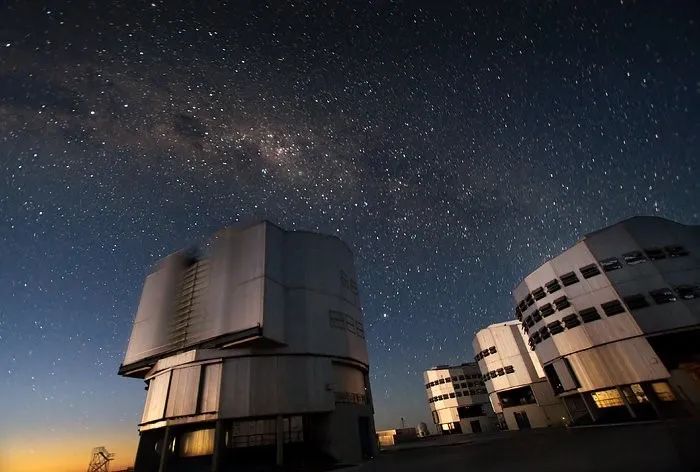
VLT-3 ("Melipal", "South Cross") HIP 65426 B image. The white cross in the picture is the position of the mother star, and its light has been blocked by the star coriander; the red celestial body is a short wave of infrared pseudo -color images of HIP 65426 B. The radius of the white circle is equal to the rail radius of the Neptune in the solar system.
Picture source: ESO
So far, astronomers have discovered 213 foreign planets with direct imaging, accounting for 3.89%of the total.
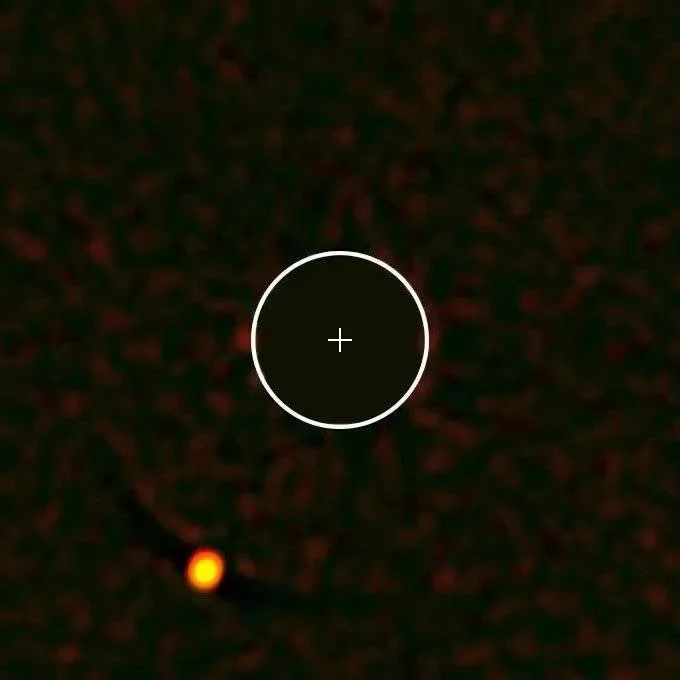
Webu's photo object -HIP 65426B
The system composed of HIP 65426 and its planet HIP 65426B is located in the direction of a half -person horse. In the most sensitive V -band of the human eye, HIP 65426 is a 7 -class star, which cannot be seen by human eye, because the limit of the stars with the naked eye is 6 or 6.5. That's why we can only use the telescope to see it.
According to the GAIA satellite measurement in 2020, HIP 65426 is about 350.6 light years from Earth. The temperature on the surface is about 8840 k, which is slightly higher than the surface temperature of the sun (5772 k). Its mass is about 1.96 times the quality of the solar. Its radius is about 1.77 times the radius of the sun. Its age is about 14 million years, which is far lower than the age of the sun (about 4.6 billion years).
HIP 65426B around HIP 65426 takes 631 years (referring to the year on the earth, the same below). In comparison, one week from the farthest planet Neptune to the sun is 164.8 years, and the dwarf planet underworld has a turnover of 247.94 years.
HIP 65426 Star Map, it is located in the center of the yellow circle, two stars (half -man horsesh star A star, Rigil key) and horse belly (halfman horse seat β star, HADAR)
Picture source: tomruen
After the HIP 65426 B was discovered by VLT-3, before Webb shot it, astronomers have studied its nature through various means. These studies show that (1) HIP 65426 B is very "young" and age is about 14 million years. In contrast, the earth is more "mature", about 4.6 billion years. (2) HIP 65426 B's atmosphere is high, lack of carbon, rich in oxygen, and carbon dioxide, but methane and ammonia are not detected. (3) The surface temperature of HIP 65426 B is about 1560 K. (4) The quality of HIP 65426 B is about 10 or 11 times the quality of Jupiter.
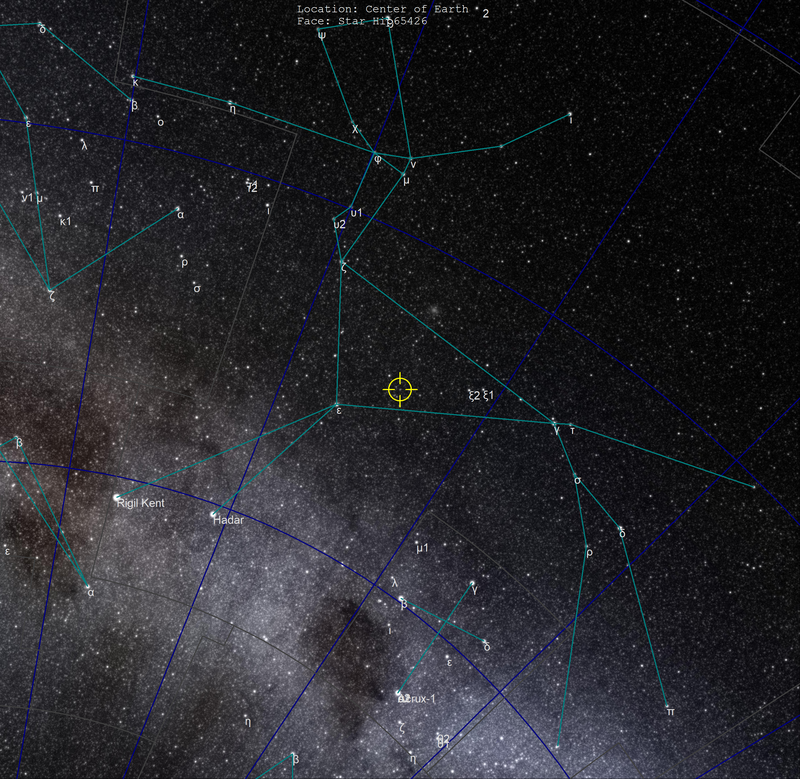
According to the theory of planet formation, when the gas and dust around the stars are gradually condensed into the planet, there will be some remnant disk substances around. To the puzzlement of astronomers, HIP 65426 B is still so young, but the surrounding disk has disappeared. This is contradictory with the current popular theoretical model. The shooting of Weibu in the infrared band (above 3 microns) is conducive to people to understand the nature of the planet more thoroughly. The Aarynn L. Carter of the Department of Astronomy and Celestial Physics of the University of California Cruz presided over the study. They used Webb to take the image of 7 bands (see the figure below. In order to make the small map more beautiful, the team only announced the image of the 4 bands to the media).
The image of HIP 65426B taken by Webb. The 7 small pictures were filmed by the average wavelength of 2.523 microns, 3.067 microns, 3.580 microns, 4.084 microns, 4.397 microns, 11.307 microns and 15.514 microns. The white five -pointed star indicates the position of the star, and the light emitted by the star itself is blocked by the star coronation.
Image source: a. Carter et al. Arxiv: 2208.14990v2
In the images taken, the angle distance between HIP 65426 and HIP 65426B is about 0.82 cents. Combined with the distance between them and the earth, Carter and others calculate the average track radius of the HIP 65426B of about 87 astronomical units (1 celestial unit equal to 150 million. A kilometer, the average distance between the earth and the sun), is about three times the average rail radius of Neptune and twice the average rail radius of Pluto.
Carter et al. Put the data obtained by Weibu with the data from the previous Sphere, which gets the brightness value within the range of 1 to 16 micron. The brightness within the wavelength range accounts for 97%of the total brightness of the HIP 65426 B.

Carter et al. Draw these data into diagrams (see the figure below).
In the figure, the seven bands obtained by Webu are represented by an orange hollow point; Sphere's integral field spectrometer (IFS) obtained near -infrared spectrum is expressed by dense black hollow triangles; Sphere's infrared difference is obtained by the infrared differential imaging instrument and spectrometer (Irdis) (Irdis). The metering point is represented by black hollow cubes; NASMYTH adaptive optical system-CONICA near-infrared camera (NACO) obtained by NASMYTH self-adaptive optical system on VLT-1 is represented by black hollow diamonds.
Above: HIP 65426B's near-infrared spectrum (hollow point on the left dense triangle), near infrared-medium infrared test data (other hollow dots, of which the orange empty dot is the data observed by Weibu), the best model fitting line ( The best value (blue solid small dot) and the model obtained in some bands (blue solid small dots) and the model of the model indicate the scope of the error range. Figure below: Residuals in each band, that is, the value obtained after the observation data minus the theoretical value.
Image source: a. Carter et al. Arxiv: 2208.14990v2
Obviously, Weibu has a metering data of more than 5 microns, and its measured value at about 4 microns is visible to the naked eye from the value of the NACO of VLT. Carter et al. Fit the data with atmospheric models (they did not include NACO data when fitting because they contradicting the data obtained by Webu).
Model fitting indicates that the temperature of HIP 65426 B is about 1673 k; the radius of HIP 65426 B is about 0.92 times the radius of Jupiter. Carter and others also combine the observation results with the evolutionary model. The obtained radius of the planet is about 1.45 times the radius of Jupiter, and the surface temperature obtained is about 1282 k. On this basis, the thermal brightness of the HIP 65426 B calculated by Carter et al. The thermal brightness of 45 times to 6.2 times of 100,000 to 100,000 of the sun thermal brightness, and then its quality is about 7.1 times the quality of Jupiter (the error is the quality of the Jupiter's quality 1.1 times).
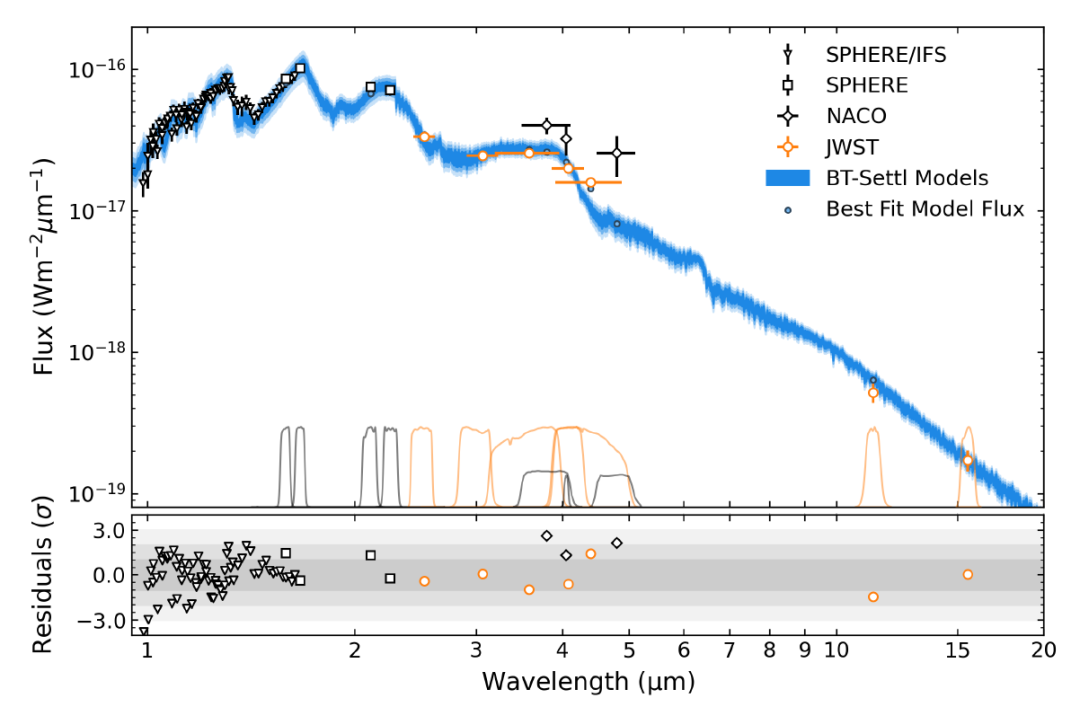
The result of Carter et al. This result has 3 times the accuracy of some of the previous physical quantities.
Weibu's performance test
In the near -infrared band and medium infrared band, the light of the mother star reflected by the HIP 65426 B is only one -ten or thousands of light of its mother star. Webb used the star's corona to block the light of the star and took this photo. From an intuitive point of view, the picture taken by Webbu is not as clear as VLT-3, but Webu shoots a longer-wavelength medium-infrared image.
Because the temperature of the outer planet is much lower than the star, a considerable part of the radiation in the infrared band is radiated. Important properties such as temperature and radius (see the above section). On this basis, people can also more accurately determine the thermal brightness and quality of the external planet.
In addition, compared to the ground telescope, the Webu shooting department has the following advantages: the telescope observation on the ground is disturbed by the atmosphere, so it is often necessary to use "adaptive optical" technology to eliminate the impact of the atmosphere; Weibu is in space, and It is not disturbed by the atmosphere, so it does not require the assistance of this technology, which allows it to obtain more accurate measurement data.
VLT-4 ("Yepun", which means "Venus") is laser, creating laser guide stars to perform the "adaptive optical" program to eliminate the impact of atmosphere on observation.
Image source: G. Hüdepohl/ESO
Carter and others believe that Webb's successful shooting shows that it has 10 times the abilities of the external planet in the shooting department.
Let our "dim blue dot" no longer alone
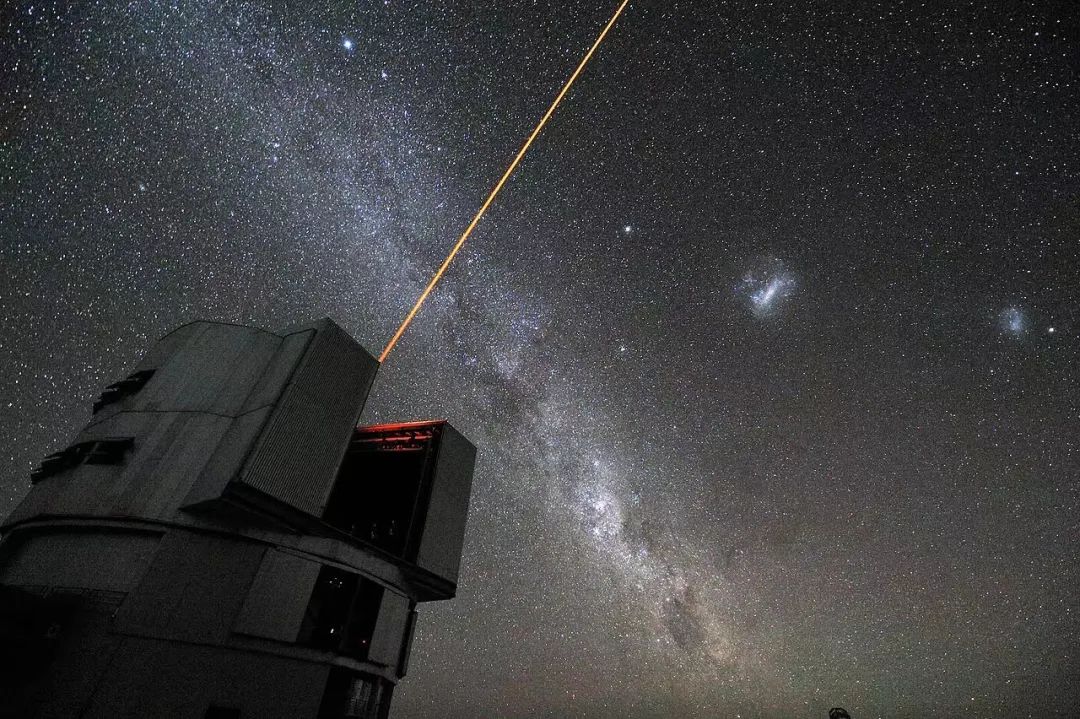
As early as 1584, Girldano Bruno (1548-1600) speculated that those stars in the sky might have planets around them. However, it was not until 1992 that human beings discovered the outer planet for the first time. At this time, it had been more than 400 years since Bruno raised this guess.
From then on, humans have developed a variety of high -precision technologies, and have discovered more than 5,000 exogenous planets and at least 8,000 candidates to be confirmed. These technologies are not only the crystallization of human mind, but also the unremitting efforts of humans when looking for the same kind of the earth.
Through this shooting, Webb proved its excellent performance in observing foreign planets, making it officially an important member of the study of foreign planet.
Weibu's observation in the infrared band is particularly important for the important numerical values such as the temperature, radius, thermal brightness, and quality of the external planet. In addition, the keen spectrometer it carries allows people to more accurately infer the atmospheric and surface chemical composition of some planets in the "livable belt" of the mother star, so that humans can further determine whether they are suitable for life survival. And evolution. In the end, Web also has the advantages of large -caliber, high sensitivity, and high accuracy.
The combination of these advantages has made Weiban have special advantages in determining the nature of the external planet and finding another "earth".
Outer planets ("Livable Planets") confirmed by astronomers may be suitable for life survival and evolution. The distance and name are given below each planet, and "LY" represents light years. From top to bottom from top to bottom, the Earth, Mars, Jupiter and Neptune from the top to bottom.
Image source: PHL @ Upr Arecibo (pHL.upr.edu)
On February 14, 1990, Voyager No. 1 (Voyager 1), who had been flying in space for more than 12 years, took a precious photo of 6 billion,000,000,000 thousands of meters from the earth. In this picture, the tiny highlight with only 0.12 pixels and seemingly insignificant is the earth, and it is almost drowned by the color light formed by the camera's reflection of the sun.
Traveler No. 1 is shot in the earth 6 billion kilometers away from the earth, and it is just a very small point in the picture.
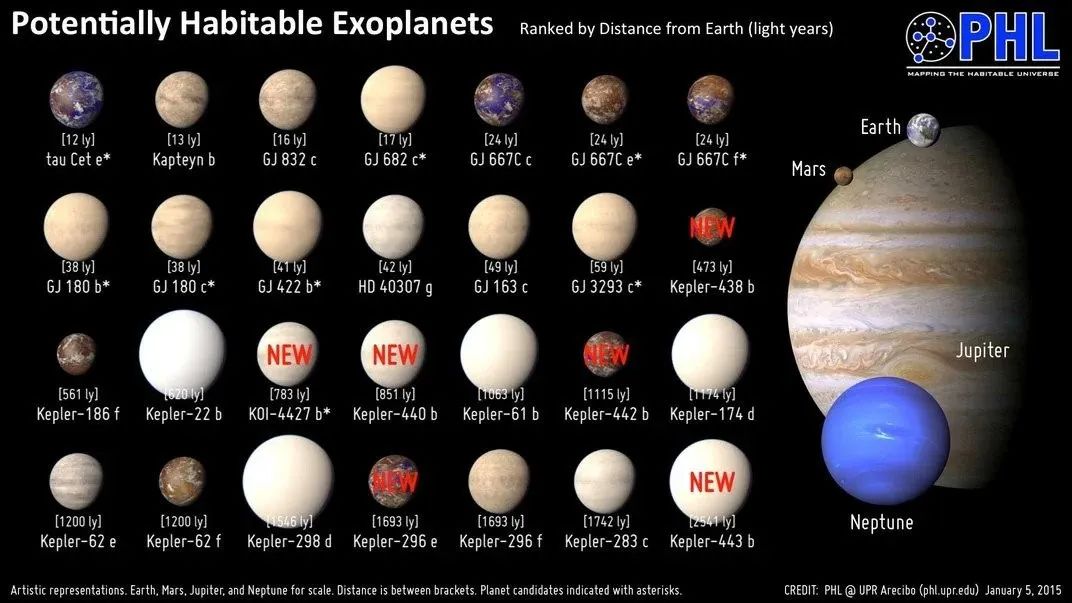
Picture source: NASA
In 1994, the famous astronomer and popular science writer Carl Sagan (1934-1996) referred to the point in the figure as "Pale Blue Dot", and used it as the name of a book. Blue dots are our precious home.
When we stare at the dim blue dots in the photo, we can't help asking: "Is our earth really lonely in the universe?" Some possible livable planets that humans have gradually discovered can make us more and more Optimisticly give this question a negative answer.
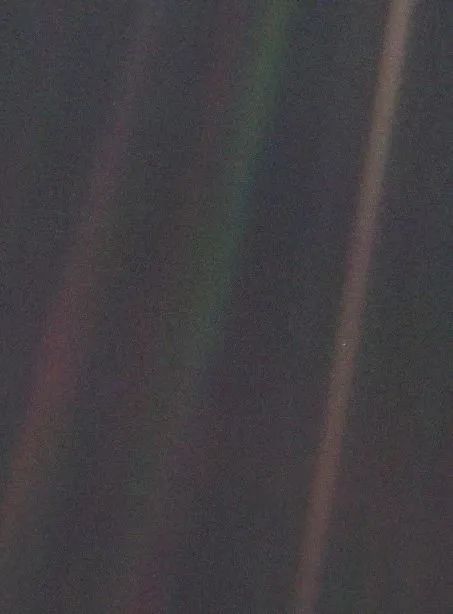
Although the various properties of these possible livable planets still have a gap with our earth, we can optimize expectations: with the help of Weibu and other powerful telescopes, humans will quickly find the nature closer to our earth, The livable planet that is more suitable for life survival and evolution, until the real other earth is found, so that our dim blue dot is no longer so lonely.
[Note 1] The number of different sources of statistics is different, and the numbers obtained according to any single source are not reliable. Here is the combination of http://exoplanet.eu/cataLog/ and https://exoplanetarchive.IPAC.CALTECH.edu/docs/counts_detail.html and consider the statistical differences between the two in Lingxing Law to get the lower limit of 5471 value.
In order to check everyone's learning effect, send a few eggs.
Question 1: The two foreign planets discovered by humans in 1992 were found in the text?
You can click the blank to view the answer
Question 2: In addition to the four most mainstream methods, what are the interesting ways to find foreign planets?
You can click the blank to view the answer
You can click the blank to view the answer
Reprinted content only represents the author's point of view
Does not represent the position of the Institute of Physics of the Chinese Academy of Sciences
Source: Science College
Edit: Just_iu

- END -
Empowering SME "Maker Beijing 2022" Innovation and Entrepreneurship Competition officially launched

Recently, the seventh Maker China Beijing SME Innovation and Entrepreneurship Comp...
The core industry scale reaches 1.5 trillion yuan, and the level of computing power in my country has gradually increased

Xinhua News Agency, Beijing, August 8th: The scale of the core industry reached 1....